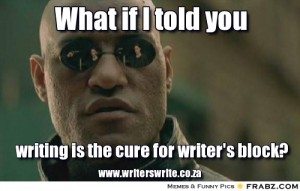It’s 11:30 p.m. and you’ve procrastinated as long as you can. Staring aimlessly into the blank white screen, you know you’re facing a wall that’s impossible to climb. No thoughts magically pop up, you have zero direction on how to approach the material, nor the slightest clue what to write about or how to even start. Welcome to Writer’s Block. You’re not alone, it’s actually a more universal battle than you think. Yet, surprisingly enough, it’s a much more winnable battle than you’ve been lead to believe.
Everyone comes to a point with writing where what to say next, or what to say at all, is elusive. I’m sure there have been countless instances where you knew what you wanted to say, you just didn’t know HOW to say it. I mean, the ideas are right up there, why can’t I get them onto the page? If only writing your thoughts down in a clear, concise, and academically acceptable manner were as easy of a task as it should be.
It happens to everyone, even the best of writers. To be perfectly honest, it took me about 30 minutes to figure out how I could finish the previous paragraph and transition into this section. I feel your pain. No one is immune to writer’s block, so hold solace in the fact you aren’t alone in this tireless endeavor. That being said, it IS a winnable battle. As tutors, we love to see breakthroughs during our consultations when a client knows exactly how to tackle their paper ,and where to go from there.
At the Writing Resources Center we apply a variety of techniques that aren’t overly complex to our tutoring sessions that have helped students along the way. If you’re ever stuck wondering how to start, a great tool you can use is simply brainstorming the main points you want to say and writing them down. As tutors, we love to ask thought provoking questions about main themes, goal of the paper, and how you can transition from one idea to another. Each of these, along with the countless other questions we can ask, really make each client think about what their intended message is. We may ask:
- “What did you feel was the main point you were trying to make?”
- “How do you see these ideas correlating, and how can we relate them?”
- “Are there any common themes you see between these ideas?”
- Answering these questions will give your content a clearer direction.
We use visual aids like cluster maps, where we write all the main points or key words down and see how we can build bridges to effectively relate these ideas. We always try to see the client’s point of view before our own, that way we can gear towards your intended message, and then try to incorporate our own insight into the conversation. Letting ideas grow and develop in this collaborative setting really seems to help get clients over the proverbial hump.
No one likes facing writer’s block, but it just feels inevitable from time to time. If you find yourself stuck you can always take a step away from the computer, get some fresh air, and let your head clear out, but always try to keep the ideas flowing. At the WRC we understand the struggles you’re experiencing, because no one is immune to this uphill battle. Everyone has great insights to share, interesting points to be made, and stories worth telling – we just want to help you get it from your thought bubble onto the page, and we’ll do it one block at a time.
